

jennifer picard
Wild orcas may not survive climate change. This piece originally appeared on The Dodo.
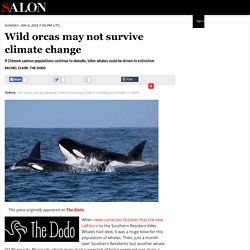
When news came last October that the new calf born to the Southern Resident Killer Whales had died, it was a huge blow for this population of whales. Then, just a month later Southern Residents lost another whale: J32 Rhapsody. Rhapsody whom many had suspected of being pregnant was given a ritual smudge ceremony prior a necropsy which confirmed she’d died with a full-term fetus in utero. Her death leaves only 77 members of the Southern Resident Community.
With this tragic news, the restoration of salmon for this dwindling population of revered and iconic whales becomes imperative. Now, with Rhapsody’s loss, the threat to this population could not be more dire. (Photo: Wikimedia) No Southern Resident calf has survived since 2012, a troubling fact underscored by L120’s death. Dr. Killer Whales (Orcas) on Pinterest. "New" Killer Whale Types at Risk From Antarctic Warming. August 04, 2008 Two newly identified types of killer whales that hunt prey off of Antarctic sea ice risk losing food sources to global warming and melting, according to a new study on the whales' movement patterns.

The study reveals that killer whales that feed primarily on fish that congregate under ice shelves are more or less "homebodies," sticking close to the ice, whereas seal-eating killer whales wander wide and seemingly aimlessly. The differences in movement patterns likely correlate to differences in the whales' foraging strategies and how they interact with their prey, according to the study.
Invasion of the Killer Whales ~ Full Episode. Of the Killer Whales A shift in power is taking place at the top of the world. 2014-11-19 01:00:00publishdisabledshowfalse11316Polar Bears Try to Catch Salmon Polar bears are forced to try their luck hunting salmon as arctic ice sheets dissappear. 01:00: of the Last Frontier: Arctic WanderersThe polar bears and arctic grizzlies in the far north of Alaska. 00:01: A shift of power is taking place at the top of the world.

The Arctic is undergoing a dramatic change, and with this change one iconic Arctic hunter may soon have to give way to another as solid ice turns to open sea. The polar bear, once king of the North, needs ice to stalk its prey. Killer whales, or orca, on the other hand, are unable to hunt in an ocean locked in ice. As the ice increasingly disappears, the tables have turned. KILLER WHALES (Orcinus orca) - Conservation & Research. Humans have observed killer whales for centuries.

A killer whale image was found carved into a rock in northern Norway and is estimated to be some 9,000 years old, making it the earliest known depiction of a cetacean. Some human cultures have long been fascinated by killer whales, but until recently their lives were shrouded in misinformation — in the past, this has led to the persecution of these whales. A few cultures respected killer whales, yet much of the ancient world did not. During the first century A.D., a Roman scholar named Pliny the Elder wrote that killer whales "cannot be properly depicted or described except as an enormous mass of flesh armed with savage teeth". Orcas (Killer Whales), Orcinus orca. Orcas (formerly known as killer whales), Orcinus orca (Linnaeus, 1758), are actually dolphins.

And they are the largest of the dolphin family (Family Delphinidae ~ 32 species, including what we normally consider dolphins, pygmy killer whales, Feresa attenuata, and false killer whales, Pseudorca crassiddens). Orcas reach a maximum length of over 9 m and can weigh up to 7,257 kg. "New" Killer Whale Types at Risk From Antarctic Warming.
Killer Whales (Orcas), Killer Whale Pictures, Killer Whale Facts. Orcas, or killer whales, are the largest of the dolphins and one of the world's most powerful predators.

They feast on marine mammals such as seals, sea lions, and even whales, employing teeth that can be four inches (ten centimeters) long. They are known to grab seals right off the ice. Basic Facts About Orcas. The orca, or "killer whale" (Orcinus orca) is a toothed whale and is the largest member of the dolphin family.
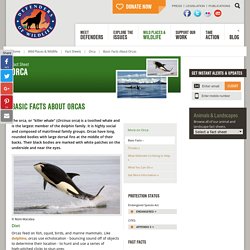
It is highly social and composed of matrilineal family groups. Orcas have long, rounded bodies with large dorsal fins at the middle of their backs. Their black bodies are marked with white patches on the underside and near the eyes. © Ronn Maratea Diet. Probable Implications of Global Climate Change on Southern ... Marine planning and conservation. Killer whales are at the top of a complex food web.
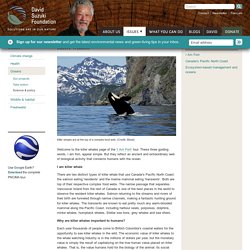
(Credit: iStock) Welcome to the killer whales page of the 'I Am Fish' tour. These three guiding words, I am fish, appear simple. But they reflect an ancient and extraordinary web of biological activity that connects humans with the ocean. I am killer whale There are two distinct types of killer whale that use Canada's Pacific North Coast: the salmon eating 'residents' and the marine mammal eating 'transients'. Killer Whale - Species Guide - WDC, Whale and Dolphin Conservation. Orcinus orca Classification: The orca is the apex predator of the sea and the largest member of the dolphin family.
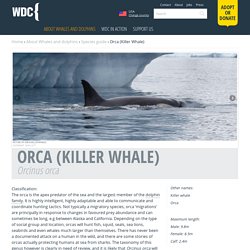
It is highly intelligent, highly adaptable and able to communicate and coordinate hunting tactics. Not typically a migratory species, orca ‘migrations' are principally in response to changes in favoured prey abundance and can sometimes be long, e.g between Alaska and California. Killer whale - Orcinus orca in Antarctica. Orcas, Sea wolves, Blackfish, Grampus Orcas / Killer Whales Statistics Maximum length: 9.8m (32.2ft) males / 8.5m (27.9ft) femalesAdult weight: males: 11.1 tonnes max. / females 8.3 tonnes max.
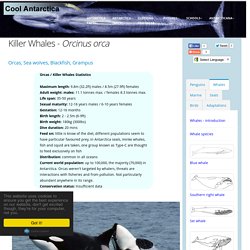
Life span: 35-50 yearsSexual maturity: 12-16 years males / 6-10 years femalesGestation: 12-16 months Birth length: 2 - 2.5m (6-9ft)Birth weight: 180kg (300lbs)Dive duration: 20 minsFeed on: little is know of the diet, different populations seem to have particular favoured prey, in Antarctica seals, minke whales, fish and squid are taken, one group known as Type-C are thought to feed exclusively on fishDistribution: common in all oceansCurrent world population: up to 100,000, the majority (70,000) in Antarctica. Orcas weren't targeted by whalers, threats are interactions with fisheries and from pollution. Not particularly abundant anywhere in its range.Conservation status: Insufficient data Killerwhales / Orca jumping off the coast of Alaska.
Why Killer Whales Go Through Menopause But Elephants Don’t. Last summer, I met Granny. I was on a whale-watching boat that had sailed south from Vancouver Island, in search of a famous and well-studied group of killer whales (orcas). Two hours after we set off, we started seeing black fins scything through the unusually calm and glassy water. We saw a dozen individuals in all, and our guide identified them by the shape of their fins and the white saddle patches on their backs.
Granny, for example, has a distinctive half-moon notch in her dorsal fin. Seeing her, I felt an intense and solemn respect. Animals almost always continue to reproduce until they die. One of the most compelling explanations is called the grandmother hypothesis. In 2012, Darren Croft at the University of Exeter found evidence to support this hypothesis.
By ploughing through the data, student Emma Foster showed that if a male orca’s mother died before his thirtieth birthday, he was three times more likely to die the next year. One reasonable guess involves salmon. Related. Orcinus orca (Killer Whale, Orca) Killer whales have been exploited at low levels in several regions world-wide (Jefferson et al. 1993). Norwegian whalers in the eastern North Atlantic took an average of 56 whales per year from 1938 to 1981. The Japanese took an average of 43 whales per year along their coastal waters from 1946 to 1981. Orca videos, photos and facts - Orcinus orca. Southern Resident Killer Whale Chinook Salmon Initiative. Killer whales' plight in ice an example of climate change impact, researcher says. Clement Rousseau Killer whales trapped in the ice near Inukjuak on Tuesday.
The pod apparently escaped Wednesday or Thursday when a path broke open. The plight of a pod of killer whales that got trapped by ice in a mostly frozen Canadian bay this week was a “good example of what climate change can do” in the Arctic, a researcher said Friday. The 11 killer whales apparently escaped the ice in Hudson Bay late Wednesday or early Thursday morning, when shifting currents helped break open a path to the sea, according to Petah Inukpuk, mayor of Inukjuak, a remote Inuit village in Quebec where locals had crafted a plan to help the animals, also known as orcas.
Other reports said there were 12 orcas in the pod. Killer Whale Menu Finally Revealed. What do killer whales dine on in Canada's remote Arctic waters? "Whatever they can catch," local Inuits say, recounting harrowing observations of pods of orcas drowning adult bowhead whales, tossing narwhals as though they were soccer balls, and ripping apart beluga whales.
Normally, such stories might be considered just anecdotes. But in an unusual collaboration, marine biologists have helped confirm the tales by talking to the hunters who know the whales best.